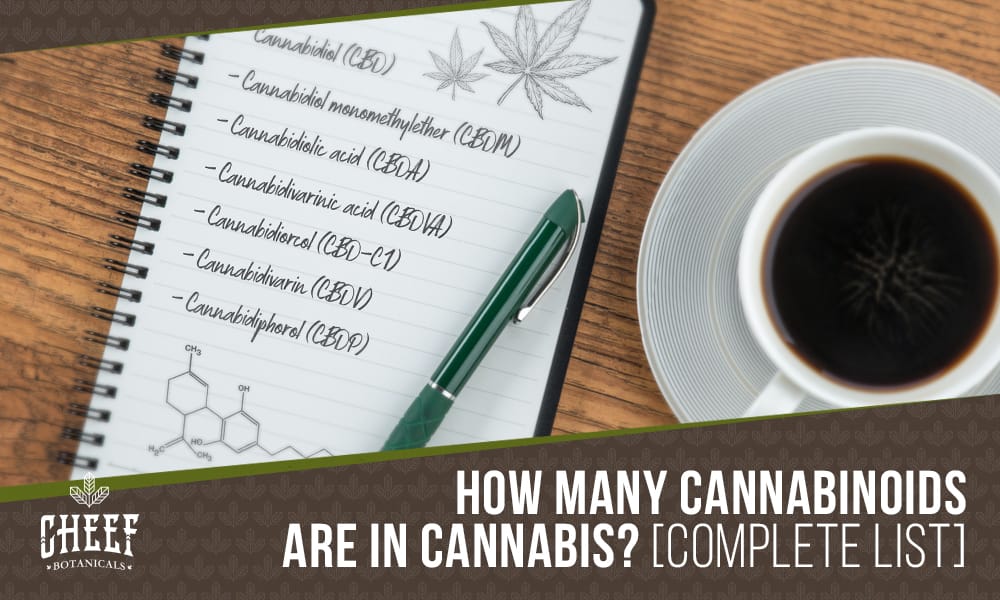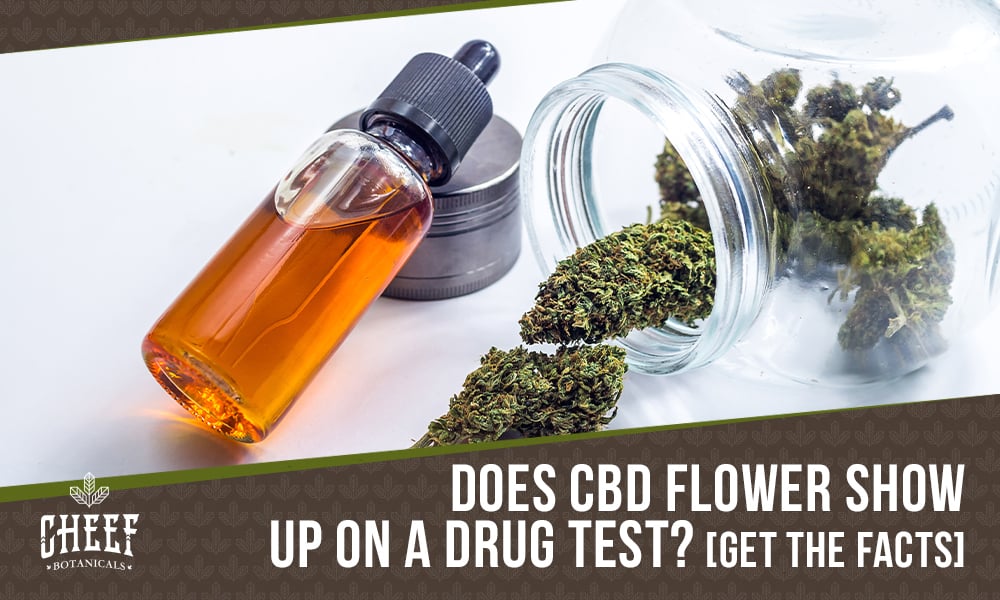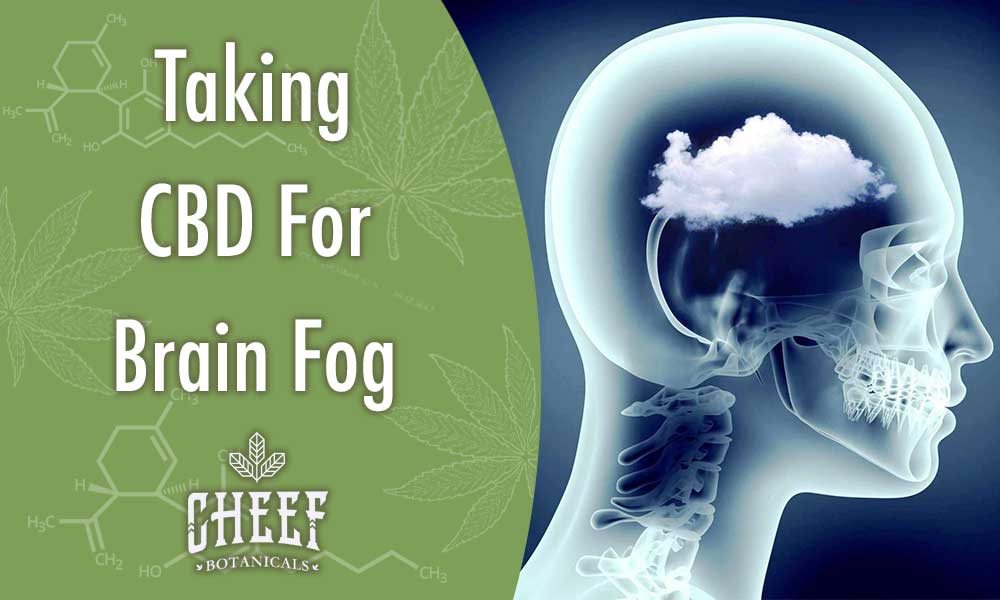By now you probably know a bit about THC and CBD, the most well-known cannabinoids. But what a lot of people may not realize is that there is a full list of cannabinoids, all with their own structures, properties, and benefits.
To help you better understand the many elements that make up the cannabis plant, we've put together a full list of the different cannabinoids found in cannabis as well as some additional information on the cannabinoids you should learn a bit about.
You can also find cannabinoids in the cannabis plant itself. These cannabinoids are called phytocannabinoids and the most well known are tetrahydrocannabinol (THC) and cannabidiol (CBD). These cannabinoids react with the receptors in our ECS, helping our body regulate and maintain homeostasis despite outside factors.
You've probably heard of THC and even CBD. But what about the other cannabinoids in cannabis? How many are there and what do they do?

What are Cannabinoids?

List of Cannabinoids - How Many are There in Cannabis?
Depending on where you go for this information, you'll find a pretty large range in the number of cannabinoids identified in cannabis. Some experts will say there's only around 60 identified cannabinoids. Additionally, others state that there's well over 100 that are already identified. The reason for this discrepancy is that many of the cannabinoids in cannabis are present at extremely low levels and scientists can sometimes have problems accurately detecting them. Plus, scientists are still discovering new cannabinoids like Delta-9-tetrahydrocannabiphorol (THCP) and Cannabidiphorol (CBDP) which were recently discovered in December 2019 by an Italian research team. What’s interesting about these two new cannabinoids is that the team claims they are up to 30 times stronger than their sister cannabinoids, THC and CBD. Despite the ongoing debate, it seems that many reliable sources agree that there are approximately 113 cannabinoids in cannabis. Although some current reports claim there are up to 150 cannabinoids in the plant.Complete List of Cannabinoids in Cannabis
While the exact number of cannabinoids is still not totally known, there are a good amount of cannabinoids in cannabis that have been confirmed, studied, researched, and explored.Cannabicyclols
- Cannabicyclolic acid (CBLA)
- Cannabicyclol (CBL)
- Cannabicyclovarin (CBLV)
Cannabichromenes
- Cannabichromene (CBC)
- Cannabichromevarinic acid (CBCVA)
- Cannabichromenic acid (CBCA)
- Cannabichromevarin (CBCV)
Cannabielsoins
- Cannabielsoin (CBE)
- Cannabielsoin acid A (CBEA-A)
- Cannabielsoic acid B (CBEA-B)
Cannabitriols
- 10-Ethoxy-9-hydroxy-delta-6a-tetrahydrocannabinol
- 8,9-Dihydroxy-delta-6a-tetrahydrocannabinol
- Cannabitriol (CBT)
- Cannabitriolvarin (CBTV)
Cannabidiols
- Cannabidiol (CBD)
- Cannabidiol monomethylether (CBDM)
- Cannabidiolic acid (CBDA)
- Cannabidivarinic acid (CBDVA)
- Cannabidiorcol (CBD-C1)
- Cannabidivarin (CBDV)
- Cannabidiphorol (CBDP)
Cannabigerols
- Cannabigerol (CBG)
- Cannabigerovarin (CBGV)
- Cannabigerovarinic acid (CBGVA)
- Cannabigerol monomethylether (CBGM)
- Cannabigerolic acid monomethylether (CBGAM)
- Cannabigerolic acid (CBGA)
Cannabinols and cannabinodiols
- Cannabinolic acid (CBNA)
- Cannabinodiol (CBND)
- Cannabinodivarin (CBVD)
- Cannabinol (CBN)
- Cannabiorcool (CBN-C1)
- Cannabivarin (CBV)
- Cannabinol methylether (CBNM)
- Cannabinol-C2 (CBN-C2)
- Cannabinol-C4 (CBN-C4)
Delta-8-tetrahydrocannabinols
- Delta-8-tetrahydrocannabinol (Δ8-THC)
- Delta-8-tetrahydrocannabinolic acid (Δ8-THCA)
Delta-9-tetrahydrocannabinols
- Delta-9-tetrahydrocannabinol (THC)
- Delta-9-tetrahydrocannabinol-C4 (THC-C4)
- Delta-9-tetrahydrocannabiorcol (THC-C1)
- Delta-9-tetrahydrocannabiorcolic acid (THCA-C1)
- Delta-9-tetrahydrocannabinolic acid-C4 (THCA-C4)
- Delta-9-tetrahydrocannabivarin (THCV)
- Delta-9-tetrahydrocannabivarinic acid (THCVA)
- Delta-9-tetrahydrocannabinolic acid A (THCA-A)
- Delta-9-tetrahydrocannabinolic acid B (THCA-B)
- Delta-9-tetrahydrocannabiphorol (THCP)
Other Cannabinoids
- 10-Oxo-delta-6a-tetrahydrocannabinol (OTHC)
- Cannabichromanon (CBCF)
- Cannabifuran (CBF)
- Cannabiglendol
- Delta-9-cis-tetrahydrocannabinol (cis-THC)
- Cannbicitran (CBT)
- Dehydrocannabifuran (DCBF)
- Tryhydroxy-delta-9-tetrahydrocannabinol (triOH-THC)
- Cannabiripsol (CBR)
What are the Most Popular? List of Cannabinoids
As you can see, there's been a pretty good amount of cannabinoids that have been discovered — and a lot of them have been studied for potential health benefits. But which cannabinoids should you be on the lookout for in your cannabis? If you want to know more about them, you should be aware of these 10 cannabinoids that are well known and heavily researched.THC – Tetrahydrocannabinol
THC is the most widely researched and most recognized cannabinoid. That's because it's the psychoactive cannabinoid that gets you "high." Research in the 1960s has led scientists to believe that THC binds itself to the CB1 receptors in our brain, resulting in the body's ECS releasing dopamine. Many consumers look to THC for its beneficial properties such as its effects on appetite, sleep, mood, and comfort levels. Although due to its psychoactive tendencies it can come with temporary side effects like memory loss, red eyes, and slower movement.CBD – Cannabidiol
Unlike THC, CBD is a non-psychoactive cannabinoid. They share many similar benefits but the “high” feeling is not one of them. In fact, many researchers believe CBD counteracts THC's psychoactive effects on the human body and mind. CBD is thought to increase the level of endocannabinoids in the body, which has led to a bunch of CBD-exclusive wellness products. CBD-derived hemp is legal in all 50 states thanks to the passing of the Farm Bill in 2018.CBG – Cannabigerol
CBG is the chemical parent of THC and CBD. While cannabis often contains less than 1% of CBG, it's essential because of its major role in the production of those important cannabinoids. CBG may also have its own therapeutic benefits. In 2015, one study claims that CBG may have neuroprotective properties. Thanks to modern growing practices, today some strains today have over 20% CBG. Our select CBG strain offers consumers 21.8% Cannabigerol.CBDV – Cannabidivarin
CBDV is a non-intoxicating cannabinoid discovered in 1969. Recent research suggests it may affect the nervous system and it's currently being studied for its possible neurological effects. Strains with a lot of CBD flower will also often have higher levels of CBDV.THCV – Tetrahydrocannabivarin
This cannabinoid is similar to THC except that it contains fewer carbon atoms. That makes it a lot less intoxicating than THC. People who have experienced strains with a lot of THCV claim that they experience a small burst of energy along with a mild high that doesn't last long at all. Like THC, it binds to the CB1 and CB2 receptors in your ECS. While research is still being done on THCV's benefits, it's become popular among people trying to lose weight.CBC – Cannabichromene
This is the third most common cannabinoid on this list, featured heavily in a lot of different strains. While it's non-intoxicating, CBC may promote overall wellness in a variety of ways. For example, there is a reason it's combined with other cannabinoids to create the "entourage effect." CBC interacts directly with CB1 and CB2 receptors in the ECS, as well as TRPA1 and TRPV1.Want to learn more about the “entourage effect? Read this next: Should I Take CBD With THC or Without it?CBC is more prevalent than CBD in a large number of strains. Dating back to the 1970s, CBC was heavily featured in landrace strains from India.
THCA – Tetrahydrocannabinolic Acid
THCA is another nonpsychoactive cannabinoid. What's interesting is that, THCA converts to the psychoactive compound THC once it's exposed to heat, this process is known as decarboxylation. For this reason, THCA is only found in raw and live cannabis plants. It's often the main component of resin concentrates, making up 50 to 90% of the weight. People interested in trying THCA can try juicing fresh cannabis.CBGA – Cannabigerolic Acid
Often considered one of the most crucial cannabinoids, no other compound would exist without this "mother cannabinoid." Currently, the majority of medical marijuana strains contain CBGA. But once it's heated, it becomes CBD. While CBGA is one of the main building blocks of cannabinoids, there isn't much research involving it.CBDA – Cannabidiolic Acid
CBDA, the acidic precursor to CBD, is a non-psychoactive cannabinoid. You can find CBDA in raw hemp or raw marijuana strains high in CBD. Once it heats up above a certain tempature, CBDA turns to CBD. Researchers believe that CBDA has an impact on the human body even before it converts to CBD. That's because it interacts with the ECS' 5-HT1A serotonin receptors, which regulate sleep, anxiety, and mood.Related Article: CBDa vs CBD
CBN – Cannabinol
Some marijuana users say that they don't want CBN in their flower since it has become a sign of stale herb. CBN is formed when a plant's THC degrades due to age or light exposure. When ingested, CBN may help people feel more rested and get better sleep. Archaeologists found about 800 grams of cannabis with high levels of CBN buried within a 2,700-year-old grave in China.Other Elements in Cannabis
You may be thinking to yourself, "Wow, I can't believe there are 113 cannabinoids in a cannabis plant!" But that's actually just the beginning. There are other components that make up this budding plant, which adds to its unique properties.Terpenes
Terpenes are the aromatic oils that provide the distinct flavors of various cannabis strains. To repel predators and attract pollinators terpenes naturally develop within the plant. There are over 100 different terpenes that are identifiable in the cannabis plant. Each strain has its own unique terpene composition. They not only provide different smells but could possibly play an important role in each strain's effects on our ECS. Some terpenes can give off a calm and relaxed feeling, while others give more energy and keep us focused.Related: CBD and TerpenesA few popular terpenes include:
- Pinene: Calming, pine scent (Found in Blue Dream, Bubba Kush)
- Terpinolene: Energizing, fruity scent (Found in Golden Pineapple, Chernobyl, Jack Herer)
- Limonene: Energizing, citrus scent (Found in White Fire OG, Do-Si-Dos, Wedding Cake)
- Myrcene: Calming, herbal scent (Founded in Harlequin, OG Kush, Cannatonic)
Flavonoids
There isn't a lot of research into flavonoids so their effects on cannabis and consumers are not well yet known. In other words, as cannabis becomes vastly normalized in the global community, more studies can determine what role flavonoids play in cannabis. Over 6,000 varieties of flavonoids exist in nature and they provide plants with their colors. Flavonoids do the same thing for cannabis (think those strains with deep purple coloring). Flavonoids makeup around 10% of the compounds produced by cannabis and come in 20 known varieties. While flavonoids have been found in other flowers, some of those varieties are unique to cannabis. There have been some studies on cannabis' flavonoids to find out exactly what they do. While the research is still young, one flavonoid, cannaflavin A, could be pharmacologically active. Studies claim that this flavonoid may interact with the immune system. Some flavonoids may also have anti-fungal and antioxidant potential. Highly active flavonoids in cannabis include:- Cannaflavin B
- Cannaflavin C
- Orientin
- Quercetin
- Silymarin
- Kaempferol




 CBD Gummies - Top Seller
CBD Gummies - Top Seller
 CBD + THC Gummy - Excellent Choice
CBD + THC Gummy - Excellent Choice
 CBD Hemp Flower - Highly Rated
CBD Hemp Flower - Highly Rated
 Full Spectrum CBD Oil - Good Value
Full Spectrum CBD Oil - Good Value



Leave a comment
This site is protected by hCaptcha and the hCaptcha Privacy Policy and Terms of Service apply.